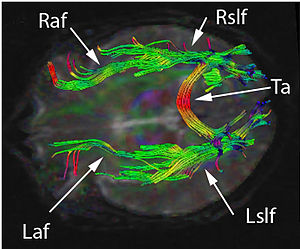Anomic aphasia
| Anomic aphasia | |
|---|---|
 |
|
| Diffusion tensor imaging of the brain shows the right and left arcuate fasciculus (Raf & Laf). Also shown are the right and left superior longitudinal fasciculus (Rslf & Lslf), and tapetum of corpus callosum (Ta). Damage to the Laf is known to cause anomic aphasia. | |
| Classification and external resources | |
| ICD-9-CM | 784.3 784.69 |
| MeSH | D000849 |
Anomic aphasia (also known as dysnomia, nominal aphasia, and amnesic aphasia) is a mild, fluent type of aphasia where an individual has word retrieval failures and cannot express the words they want to say (particularly nouns and verbs). Anomia is a deficit of expressive language. The most pervasive deficit in the aphasias is anomia. Some level of anomia is seen in all of the aphasias. Individuals with aphasia who display anomia can often describe an object in detail and maybe even use hand gestures to demonstrate how the object is used but cannot find the appropriate word to name the object.
Anomic aphasia (anomia) is a type of aphasia characterized by problems recalling words, names, and numbers. Speech is fluent and receptive language is not impaired in someone with anomic aphasia. Subjects often use circumlocutions (speaking in a roundabout way) in order to avoid a name they cannot recall or to express a certain word they cannot remember. Sometimes the subject can recall the name when given clues. Additionally, patients are able to speak with correct grammar; the main problem is finding the appropriate word to identify an object or person.
Sometimes subjects may know what to do with an object, but still not be able to give a name to the object. For example, if a subject is shown an orange and asked what it is called, the subject may be well aware that the object can be peeled and eaten, and may even be able to demonstrate this by actions or even verbal responses – however, they cannot recall that the object is called an "orange." Sometimes, when a person with this condition is multilingual, they might confuse the language they are speaking in trying to find the right word (inadvertent code-switching).
There are three main types of anomia:
Anomia is caused by damage to various parts of the parietal lobe or the temporal lobe of the brain, which is now often a targeted area of anomia research. This damage can be caused by a congenital condition or a brain trauma, such as an accident, stroke, or tumor. This type of phenomenon can be quite complex, and usually involves a breakdown in one or more pathways among various regions in the brain.
Although the main causes are not specifically known, many researchers have found factors contributing to anomic aphasia. It is known that people with damage to the left hemisphere of the brain are more likely to have anomic aphasia. Broca's area, the speech production center in the brain, was linked to being the source for speech execution problems, with the use of functional magnetic resonance imaging (fMRI), now commonly used to study anomic patients. Other experts believe that damage to Wernicke's area, which is the speech comprehension area of the brain, is connected to anomia because the patients cannot comprehend the words that they are hearing.
...
Wikipedia
